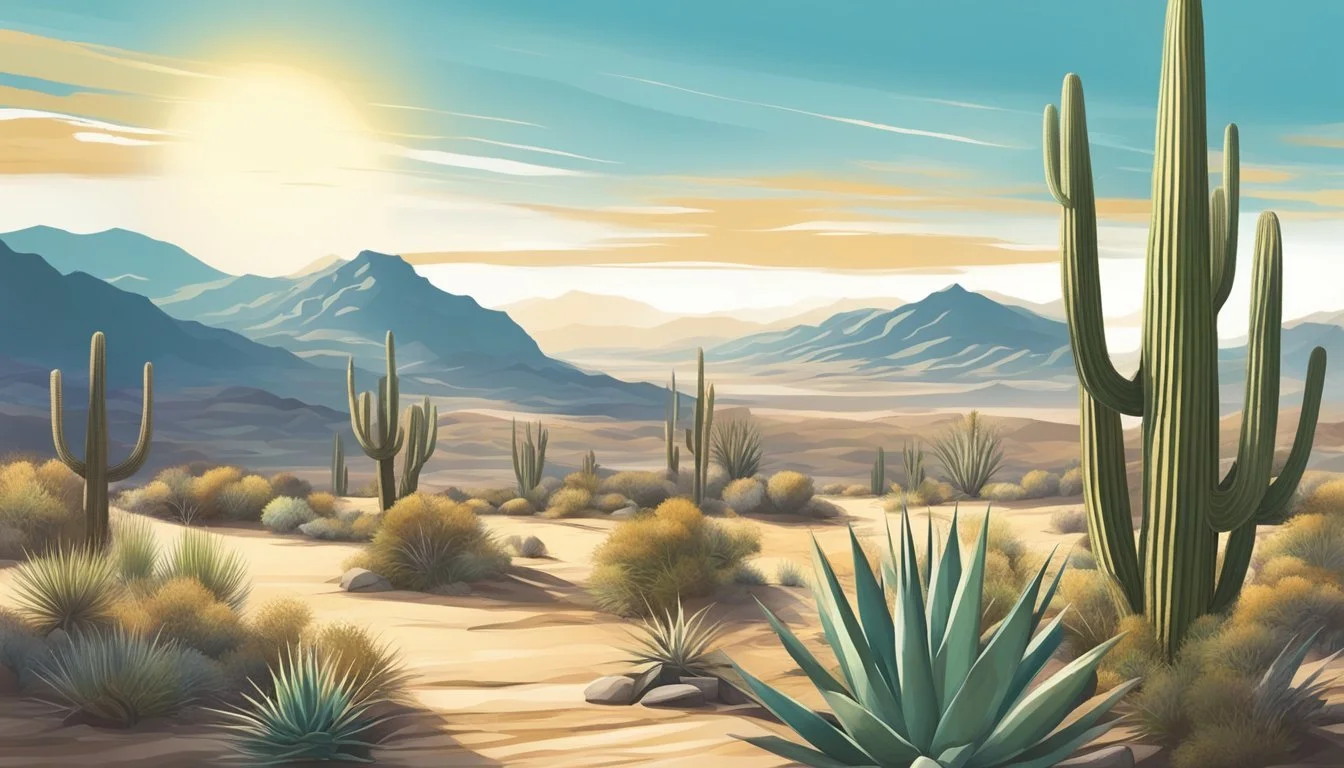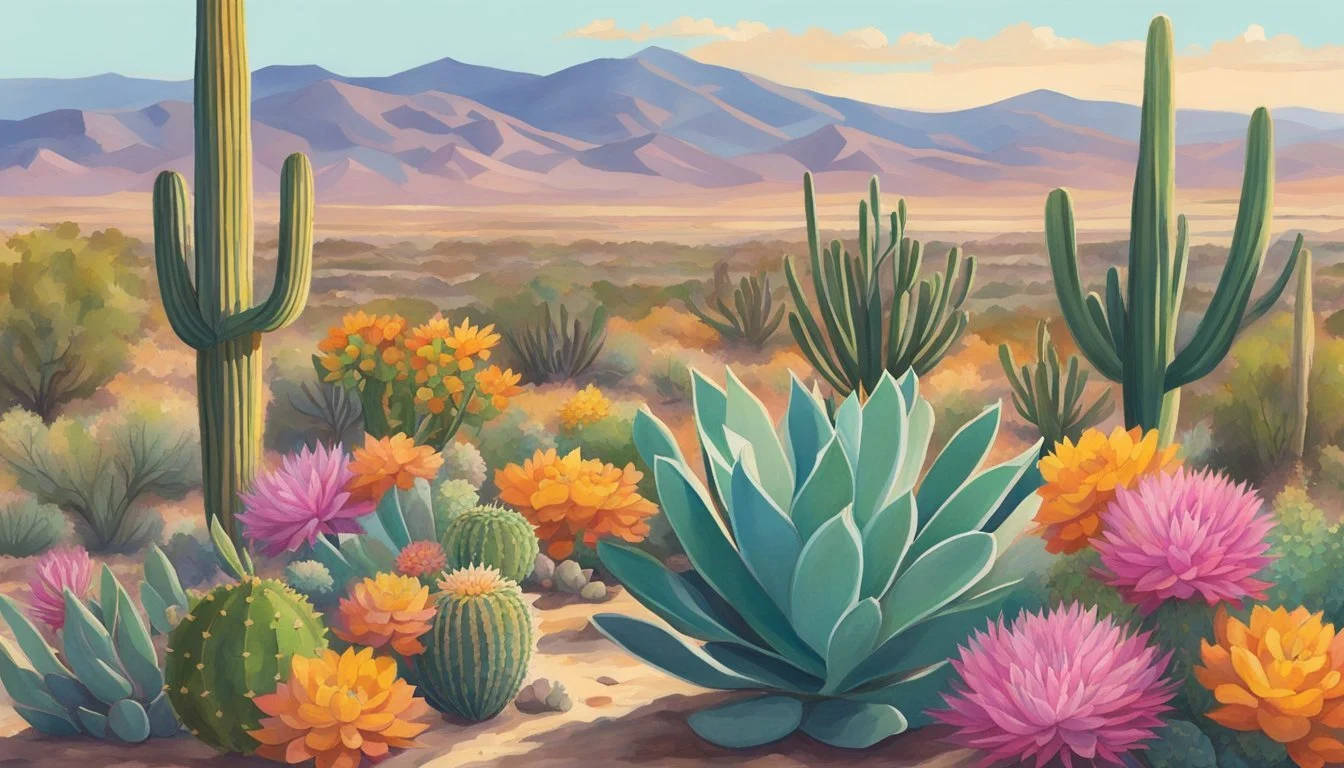Drought-Tolerant Plants in New Mexico
A Guide to Resilient Landscaping
Drought-tolerant plants are essential to New Mexico's landscape design due to the region’s arid climate and restricted water resources. As water conservation becomes increasingly important, homeowners and landscapers are seeking out species that can thrive without frequent irrigation. These plants not only offer a viable solution to the challenges of gardening in dry conditions but also contribute to the conservation of a precious resource.
In New Mexico, choosing the right plants for a garden or landscape means considering those that have adapted to the dry environment. This approach to gardening often uses principles of xeriscaping, which incorporates water-efficient techniques to create a visually appealing landscape. The selection of drought-tolerant plants, such as various types of yucca or the resilient Prickly Pear Cacti, can greatly reduce the need for water without sacrificing the area's natural beauty.
Moreover, with thoughtful landscape design, gardeners in New Mexico can create spaces that are both sustainable and attractive. Utilizing native plants is not only practical for water conservation but also beneficial for local wildlife, providing habitats and food sources. From the sculptural silhouettes of drought-resistant trees to the vibrant blooms of native wildflowers, these plants bring life and color to the desert landscape.
Understanding Drought Tolerance
Drought tolerance in plants is a critical factor for successful cultivation in arid regions such as New Mexico. This type of tolerance allows plants to withstand periods of low water availability, making them suitable for landscapes where water conservation is paramount.
Physiological Adaptations: Plants that are drought-tolerant often exhibit certain physiological adaptations. These include deep root systems that tap into underground water reserves and reduced foliage to minimize water loss. Additionally, some plants possess a thick cuticle or wax-coated leaves to reduce transpiration, the process where water evaporates from the leaf surface.
Heat and Temperature: Drought-tolerant plants are typically well-suited to handle higher temperatures. They often thrive in environments where heat can intensify the effects of drought. These species have adapted to maintain functionality and manage internal water levels despite external heat stresses.
Water Use Efficiency: A key characteristic of drought-tolerant plants is their efficient water use. They often employ strategies like CAM (Crassulacean Acid Metabolism) photosynthesis, allowing them to open stomata at night to reduce water loss.
Adaptation Strategy: Deep Root System
Description: Access deep water sources
Adaptation Strategy: Reduced Foliage
Description: Lower transpiration rates
Adaptation Strategy: Thick Cuticle
Description: Minimize water loss
Adaptation Strategy: CAM Photosynthesis
Description: Optimize water use during photosynthesis
In conclusion, understanding these traits can assist gardeners and landscapers in selecting appropriate plants for New Mexico landscapes that require minimal water input while still providing aesthetic and ecological value.
Climate and Soil in New Mexico
New Mexico's climate presents challenges for plant cultivation, necessitating a careful consideration of heat tolerance and soil management. With its arid environment and predominantly alkaline soils, appropriate plant selection and soil preparation are pivotal for successful gardening and agriculture in the state.
Heat and Temperature Considerations
In New Mexico, daytime temperatures can soar, especially during the summer months, making it essential for gardeners to choose plants that can thrive in extreme heat. Many areas experience a wide temperature range between day and night, which plants must adapt to. Drought-tolerant plants are a practical choice, as they are well-suited to the hot and arid conditions prevalent throughout much of the state.
Soil Types and Drainage
The state's soils are often alkaline, with pH levels that can impede the availability of nutrients to plants. High alkalinity is common in the arid regions due to the low rainfall that fails to leach salts from the soil. These soils also tend to be well-drained, which is beneficial for plants that do not tolerate waterlogged roots but may require additional watering during the drier periods. It is crucial to amend the soil with organic matter to improve its structure and nutrient content, encouraging healthy plant growth in New Mexico’s challenging conditions.
Native Drought-Tolerant Trees
New Mexico's arid environment necessitates the use of plants that can thrive with minimal water. Several native tree species have adapted to these conditions, possessing unique features allowing them to conserve water yet still provide aesthetic appeal and habitat support.
Desert Willow
Chilopsis linearis, commonly known as the Desert Willow, is a beautiful flowering tree with willow-like leaves. It typically grows in the arid and semi-arid lowlands and foothills. The tree is characterized by its long, narrow leaves and capability to withstand dry conditions. The Desert Willow produces lovely, trumpet-shaped flowers which attract pollinators such as hummingbirds.
Honey Mesquite
Another resilient tree is the Honey Mesquite (Prosopis glandulosa), well-suited for New Mexico's dry climate. Honey Mesquite trees are recognized by their compound leaves and rugged, deeply furrowed bark. They have an extensive root system that taps into deep water sources. As a result, they can endure periods of drought with ease. These trees also offer the added benefit of producing nutritious seed pods that are vital for local wildlife.
Blue Palo Verde
The Blue Palo Verde (Parkinsonia florida), literally translating to "green stick," is a distinctive tree with greenish branches and leaves, which is an adaptation to conserve water. It's a small to medium-sized tree that flourishes in the sunny, arid zones of New Mexico. During spring, the Blue Palo Verde is adorned with bright yellow blossoms, offering a striking contrast against the clear blue skies.
Drought-Resistant Shrubs and Bushes
When selecting shrubs for New Mexico landscapes, it is essential to choose species that are adaptable to arid conditions and can thrive with minimal water use. The following selections are notable for their resilience and low maintenance requirements, providing beauty and utility to the garden with minimal environmental impact.
Rose of Sharon
Rose of Sharon (Hibiscus syriacus) is a durable deciduous shrub that can stand up to the heat and sporadic rainfall in New Mexico. With a wide variety of colorful blooms, it adds visual interest from summer to fall. This shrub demands little water once established and grows well in full sun to partial shade.
Apache Plume
The Apache Plume (Fallugia paradoxa) is a native evergreen shrub that exemplifies the rugged beauty of the Southwestern terrain. Its distinctive feathery seed heads and white flowers are a magnet for wildlife. Apache Plume prefers full sun and thrives in well-drained soil, requiring minimal water and maintenance.
Chitalpa
Chitalpa (x Chitalpa tashkentensis) is a hybrid deciduous shrub with a rapid growth rate and the ability to tolerate drought conditions. It showcases an impressive display of tubular pink flowers throughout the summer. Chitalpa is well-suited for New Mexico gardens, demanding little water and care while providing dense canopies of elongated leaves and vibrant branches.
Xerophytic Perennials and Groundcovers
Xerophytic perennials and groundcovers thrive in New Mexico's challenging climate, requiring minimal irrigation while offering diverse textures and forms for a dynamic landscape. These plants possess adaptations that allow them to conserve water, making them ideal choices for low-water-use gardening.
Ocotillo
Ocotillo (Fouquieria splendens) is a distinctive native plant that exemplifies the essence of xeric landscaping. With its slender, spiny canes and fiery red blooms, Ocotillo demands little water yet delivers high visual impact, especially when it leafs out following rainfall.
Agave and Succulents
Agave species and various succulents form the backbone of water-wise gardens. They provide sculptural silhouettes and often require only the scantest moisture to maintain their robust form. Products such as 27 of the Best Xerophytes to Plant can help gardeners select varieties that are both functional and aesthetically pleasing.
Ornamental Grasses
Ornamental grasses bring movement and softness to the landscape. Grasses like Blue Grama (Bouteloua gracilis) and Pink Muhly (Muhlenbergia capillaris) tolerate drought once established, creating a sea of waving foliage and airy inflorescences that require little water to prosper.
Flowering Plants for Arid Landscapes
In New Mexico's arid environments, certain flowering plants not only survive but brighten the landscape, especially those that attract hummingbirds and butterflies. These plants often exhibit a fusion of vibrant colors and hardy nature, which makes them ideal for water-wise xeriscaping projects to create a natural, low-maintenance garden.
Hummingbird Attractors
Hummingbird attractors are flowering plants that provide ample nectar and exhibit bright colors like red and pink. One such plant is the Red Yucca (Hesperaloe parviflora), with its tall spikes of crimson flowers that persist through the heat. Another favorite is the Penstemon, which offers various species that produce tubular flowers perfect for a hummingbird's slender bill.
Red Yucca (Hesperaloe parviflora)
Flowers: Crimson, tubular
Blooming Period: Early summer to fall
Attraction: Hummingbirds
Penstemon (Penstemon spp.)
Flowers: Varying colors including pink and red
Blooming Period: Spring to early summer
Attraction: Hummingbirds
Plants like Blue Mist Spirea are also known to be excellent for inviting hummingbirds into the garden.
Butterfly-Friendly Varieties
Butterfly-friendly varieties are those that provide both the nectar adult butterflies need for energy and the plant material caterpillars require to grow. For butterflies, selections of plants such as Catmint (Nepeta spp.) and Black-eyed Susan (Rudbeckia hirta) are particularly enticing due to their abundant blossoms and ability to thrive in tough soil conditions.
Catmint (Nepeta spp.)
Flowers: Blue to purple spikes
Blooming Period: Late spring to early fall
Attraction: Butterflies
Black-eyed Susan (Rudbeckia hirta)
Flowers: Bright yellow with a dark center
Blooming Period: Summer
Attraction: Butterflies
The Catmint's enchanting spikes of blue and purple flowers are not only a beautiful sight but a beacon for butterflies in the heat of New Mexico.
Landscape Design with Drought-Tolerant Plants
In New Mexico’s arid climate, the selection of drought-tolerant plants is essential for a sustainable and visually appealing landscape design. By choosing native plants and strategically planning their placement, homeowners can create a garden that conserves water while providing year-round aesthetic value.
Creating an Efficient Water-Usage Garden
To optimize water usage in the garden, homeowners should start by grouping plants with similar watering needs to create hydrozones. This allows for more targeted irrigation that avoids over- or under-watering. Mulching is also crucial as it helps retain moisture in the soil, decreasing the need to water frequently. Here’s a brief list of native plants that thrive in New Mexico with minimal water:
Blue grama grass (Bouteloua gracilis)
Creosote bush (Larrea tridentata)
Purple coneflower (Echinacea purpurea)
By incorporating these plants into the landscape design, gardeners can conserve water and ensure their garden is resilient against drought conditions.
Aesthetic Considerations
Aesthetic value does not have to be sacrificed for water efficiency. The use of native plants such as yucca and agave can provide sculptural elements to the garden, creating a visually engaging space. Plants can serve as decorative features or even as functional screens or hedges. For a cohesive look, consider the following elements in the design:
Color: Seasonal blooms of the blanket flower (Gaillardia) add vibrant reds and yellows.
Texture: The fine foliage of feather grass (Nassella) contrasts with the bold leaves of agave.
Height: Varying plant heights with low groundcovers alongside taller shrubs or ornamental grasses offers depth.
Care and Maintenance of Drought-Tolerant Flora
Drought-tolerant plants in New Mexico offer an efficient solution to landscaping in arid conditions, due to their low maintenance and minimal water needs. However, appropriate care ensures their health and aesthetics.
Watering Best Practices
Proper watering is crucial for drought-tolerant plants. They require deep, infrequent watering to promote robust root growth. Initially, water new plants to help establish roots, then gradually taper off. They should be watered early in the morning, which minimizes evaporation and aids in preventing fungal diseases.
Frequency: Every 7-10 days during growing seasons; less in winter.
Amount: Typically 1 inch of water, reaching 6-12 inches into the soil.
Pruning and Shaping
Regular pruning and shaping not only maintain the plant's appearance but also encourage healthy growth. Remove dead or damaged limbs to prevent disease and pest infiltration. It is best to prune during the dormant season to minimize stress on the plants.
Spring bloomers: Prune after flowering.
Summer/Fall Bloomers: Prune in early spring.
Managing Pests and Diseases
Drought-tolerant plants are not immune to pests and diseases, but they are generally more resistant. To manage infestations:
Inspect regularly for signs of trouble.
Use environmentally friendly pesticides or horticultural oils as needed.
Remove any diseased parts promptly to prevent spreading.
Proactive monitoring and maintenance keep the plants healthy and reduce the need for chemical interventions.
Frequently Asked Questions
This section addresses common queries regarding drought-tolerant flora suitable for New Mexico's unique environment, allowing gardeners to make informed choices.
What are the top choices for ground cover plants that flourish in New Mexico's dry conditions?
Top ground cover choices for this region include Stonecrop Sedum, which boasts succulent leaves and is regarded for its drought tolerance, and Ice Plant, known for its vibrant flowers and low water needs.
Which shrubs are best suited for xeriscaping in New Mexico's arid climate?
For xeriscaping, consider the hardy Butterfly Bush and Sagebrush, both of which exhibit resilience to dry conditions and add aesthetic appeal to water-conserving landscapes.
Can you list low maintenance plants that are well-adapted to New Mexico's drought conditions?
Yucca and various species of Agave are exceptional for their low maintenance and adaptability to the arid New Mexico climate, requiring minimal watering once established.
What are some of the most drought-resistant flowering bushes recommended for New Mexican landscapes?
Lavender and Russian Sage are flowering bushes highly recommended for New Mexico landscapes due to their drought resistance and ability to thrive in full sun with very little water.
What types of trees thrive in New Mexico despite limited water availability?
Drought-tolerant trees like the Honey Mesquite and the Desert Willow are excellent for New Mexico, offering shade and greenery without demanding significant water resources.
What native plants are optimal for creating a xeriscape garden in New Mexico?
Native plants such as the New Mexico Privet and Four-wing Saltbush are optimal choices for xeriscaping, well-adapted to the local climate and contributing to the ecosystem's health.









